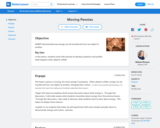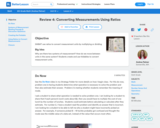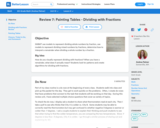
Students get a chance to use tables when breaking a total quantity into its component parts.
- Subject:
- Mathematics
- Material Type:
- Lesson Plan
- Provider:
- BetterLesson
- Date Added:
- 12/01/2022

Students get a chance to use tables when breaking a total quantity into its component parts.

Students will be making sense of problems and looking for structure in this lesson about real life rates and unit rates.

In this lesson, students are asked to examine a model for a space station on Mars that will house six researchers studying the possibility of establishing a colony. Given the dimensions of the station and the minimum amount of space needed for each person, students are asked to determine whether each researcher has sufficient living space.

Too Tall Tina is a book about a student who is obsessed with being too tall. It shows examples of many measurement comparisons.

Fish Eyes is a math story, but it is not focused on length. I use this book to have the students compare the length of the different fish in the story.

Students will become more comfortable making sense of equations presented in missing answer (traditional) and missing number ( nontraditional) formats.

Which operation should I use to solve this problem? How can I use bars to model what is going on? What are scholarships and how do I earn them? Students apply their knowledge of decimal operations to answer these questions.

Students will demonstrate how energy can be transferred from one object to another. They will work with pennies to develop questions and predict what happens when objects collide. Resources include videos of the lesson in action and a Bill Nye video.

What are multiples? How do they compare with factors? Students work to answer these questions and develop an understanding of greatest common factor and least common multiple.

Multiplying decimals is a life skilled used in purchasing goods, cooking, and spending money.

Students will use their understanding of multiplying fractions and apply it to dividing fractions which is a key component in common core. Included in this lesson are a closing activity, a link to a website for area models, and a video explanation of an activity.

A conceptual understanding of finding surface area using nets instead of a formula.

Students write and read aloud an exaggerated story using multi-digit numbers up to 1,000,000.

SWBAT share their knowledge through the assessment provided

In this lesson, students design and create a foldable that consolidates what they have learned about photosynthesis and cellular respiration.

The students will be taking a summative assessment about rates and unit rates.

Stop! It's Data Time. Every time your read me from the left or the right. It's the numbers on the board, that make the data right. Students take part in a quick survey to start the lesson and then continue to work on their data representations.

Why are there two systems of measurement? How do we move between units in the same system? Students create and use foldables to convert measurement units.

How do you visually represent dividing with fractions? When you have a remainder, what does it actually mean? Students look for patterns and create algorithms for dividing with fractions.

This lesson brings all the pieces together to have students show the how's and why's by using GCF,LCM, Distributive property and dividing fractions.